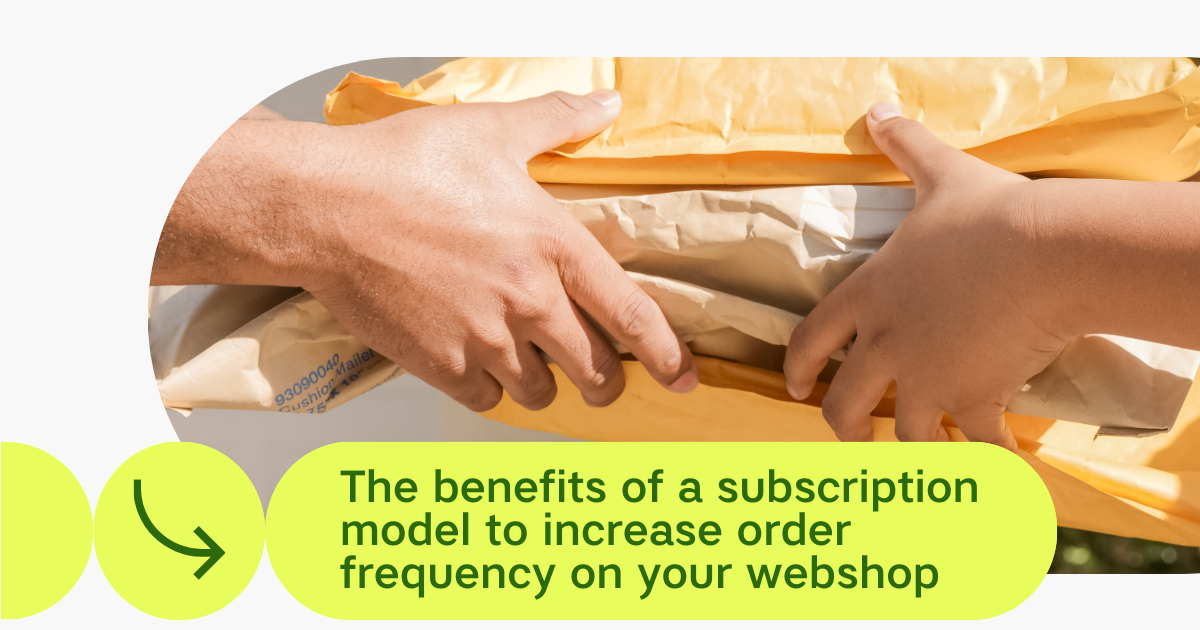The last week of October, we attended some interesting lectures with The Dotters during the ‘Digital First’ event. During one of the many lectures, we met Frederik Van Baelen (Commercial Manager e-commerce at Delhaize), who explained an interesting case related to the roll-out of a subscription model with the goal of increasing order frequency without significantly decreasing the average order value.
This interesting case made us think about how a subscription model can be interesting for our customers. Obviously it is not applicable for every type of product, but for e.g. practical products that the consumer needs on a monthly basis, this model can help to increase your revenue. Below we list some important advantages:
- Predictability: based on a subscription model you have better visibility of the volume you need weekly/monthly depending on the number of subscribers and their weekly/monthly order.
- Cash flow: subscriptions are usually paid in advance making this positive for your cash flow.
- Higher margin: often the margins are higher with a subscription model which allows this type of model to grow faster
- Returning customers: turning a new customer into a returning customer is interesting and was one of the main factors for Delhaize to start a subscription model. By means of a subscription you ensure that your consumer purchases more frequently, which is cheaper than acquiring new customers all the time.
- Communication channel: the subscription model ensures that you are in contact with your consumer on a monthly/weekly basis, allowing you to develop a more in-depth relationship.
- Feedback: in addition, the subscription model can also make it easy for consumers to provide feedback. Because they purchase from you multiple times, feedback is provided more quickly. This information can be instructive.
- No peaks: as a brand you are not dependent on certain seasonalities or high days such as Black Friday, Valentine’s Day, St. Nicholas, etc. As a result, your distribution will always be prepared for this and you will less often have to deal with disappointed customers when packages are not delivered on time.
Of course, a subscription model has not only advantages but also some disadvantages:
- Subscription fatigue: the customer can quickly tire of your products when you send out the same thing weekly/monthly. Therefore, it is important that you offer a variety of products within your subscription model so that the consumer has choice.
- Inventory management: there will be periods when your subscription model grows stronger than expected. It is important that you are prepared for this so you do not run out of stock.
- Growth limitation: within a subscription model, a major goal is to acquire new customers and convince them of your model. It is difficult to increase the value per current customer once they are in the subscription model. This can cause your growth to be more limited than retailers who can upsell and cross-sell.
- Larger problems: chances are that when problems arise they are often of a larger nature than at a regular retailer.
- Limited supply: often the supply within a subscription model is more limited than with a regular retailer.
The above advantages and disadvantages are elements that Delhaize also took into account when building their subscription model. The Delhaize subscription model looks like this: you choose a formula (3 months or 12 months) and once you have paid, you can do your shopping whenever you want and it is delivered for free on your favorite day and favorite time slot. In this way, Delhaize is already addressing two major drawbacks, subscription fatigue and limited supply. By offering the wide range of products Delhaize has to offer, customers can always order products they need at that moment. In addition, they also increase the returning customer rate this way. Furthermore, they also offer a 3-month plan which proves to be attractive to new customers. Another important factor that affected Delhaize was the average order value. By offering free shipping at any time, this obviously went down. Therefore, Delhaize conducted a number of tests which showed that when they offer an incentive from a certain amount, both the returning order frequency and the average order value increased.
Finally, here are some interesting tips and tricks related to launching a subscription model.
- It is important to first launch the model via a soft launch. This means that you first introduce it to your warm customers and see how it catches on. This way, Delhaize discovered that their first subscription model caused their average order value to drop too much, making it no longer interesting.
- Furthermore, you can also collect some interesting learnings regarding the customer journey. Is it too long, is everything going smooth, are there certain elements that are missing in the customer journey? These learnings will be important when actually launching your model to new customers.
Of course, a subscription model is not applicable for every type of product and it is important to consider whether this is something your consumer can benefit from. Interested in rolling out a subscription model for your product, but don’t know where to start? Then contact The Dotters!
This post is also available in: Dutch




